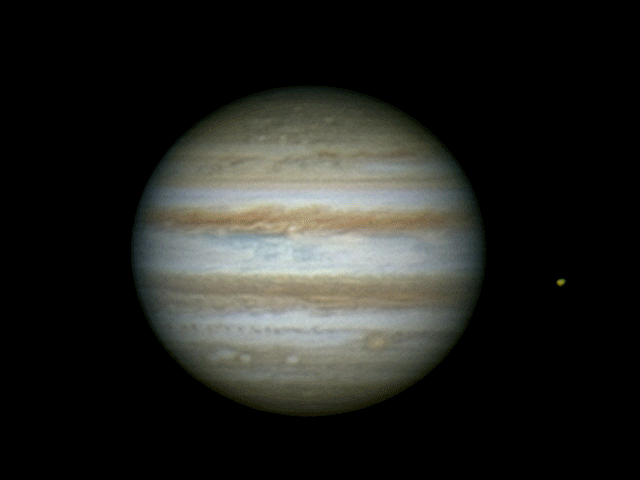Io Transit of Jupiter

When one of the four large Galilean moons of Jupiter crosses in front of the planet's disk, the sight can be truly dazzling. But taking a movie of the event is not as straightforward as pointing the camera and clicking "Record".
First, Jupiter's disk is really small in the sky - about the angular size of a crater on the Moon. So you need a big scope, preferably a large-diameter reflector for optimal resolution. Lucky thing - that's what we have right here at the Lazar Observatory!
Then the whole shebang is always rising and setting in the sky, so you have to track it. That large reflector telescope has to move like clockwork to follow the planet. And it better be aligned to the North Pole with Swiss precision, or the planet will quickly drift out of view. Lucky thing again - we happen to have a super-duper computerized mount that does the job admirably.
Third, the Earth's atmosphere boils and roils and makes Jupiter look like an Impressionist painting underwater. A single image doesn't show much more than a fuzzy blob. So this is where our spooky friends at the National Reconnaissance Office come to our rescue. See, they figured out long ago that if you take 4 images of a Russian airfield, you get twice the signal-to-noise ratio. Sixteen images gives you 4 times, and so on - your image improves as the square root of the number of frames. Got it? There will be a quiz later.
So you take a movie. This is the lowest-tech part of the process. You actually use a converted webcam. No kidding.
Once you have a one-minute video (1200 frames) into your computer, you crunch the data through a program that orders the frames by clarity. Then you keep the best 800 or so and stack them into just one picture. The result is nothing short of miraculous - details pop out that you'd never see in a single frame.
So then you wait 9 minutes and repeat. Do this 24 times over 4 hours and you have 24 frames from which you make the final movie - what you see above. But to get here, you had to crunch nearly 30,000 images and 20 gigabytes of data.
Note Io's shadow following the moon as it transits. Io is almost exactly the same size as Earth's Moon, and at the distance of Jupiter at opposition (about 400 million miles) you can discern a small disk.










